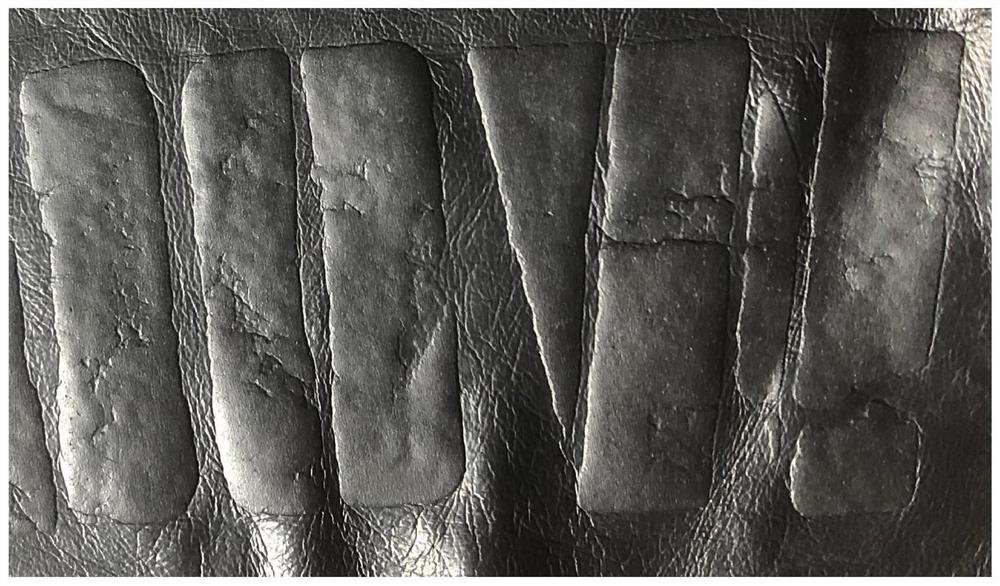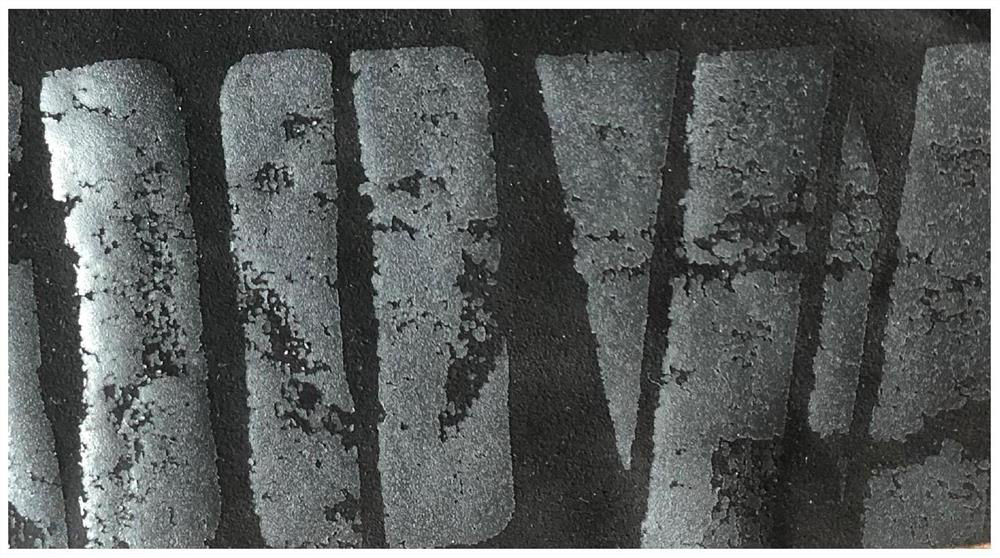A printing process for forming leather surface foaming effect on textile substrate
A leather surface foaming and printing technology, which is applied in the directions of printing, post-processing of printing, copying/marking methods, etc., can solve the problems of substrates that are easy to damage the edge of the pattern, easy-to-run shape, and long consumption time. Production cost and production time, ensure the quality of use, and improve the effect of work efficiency
- Summary
- Abstract
- Description
- Claims
- Application Information
AI Technical Summary
Problems solved by technology
Method used
Image
Examples
Embodiment 1
[0025] A printing process for forming leather surface foaming effects on textile substrates, specifically comprising the following steps:
[0026] (1) Get the release PET film, print black TPU ink on the release surface of the release PET film, dry or dry for use;
[0027] (2) print elastic TPU transparent oil on the black TPU ink surface that step (1) forms, dry or dry stand-by;
[0028] (3) Print foaming pattern glue on the elastic TPU transparent oil surface formed in step (2), dry or dry for later use;
[0029] (4) Print hot melt adhesive on the surface of the foamed glue formed in step (3), dry it or dry it for 10 minutes, put it in an oven at 120°C, bake it for 20 minutes, take it out and cool it;
[0030] (5) Take the textile substrate, and compound the hot-melt adhesive surface formed in step (4) with the textile substrate through a pressing machine. The temperature of the pressing machine is 100°C, the pressure is 30kg, and the composite time is 30s;
[0031] (6) Co...
Embodiment 2
[0035] A printing process for forming leather surface foaming effects on textile substrates, specifically comprising the following steps:
[0036] (1) Get the release PET film, print black TPU ink on the release surface of the release PET film, dry or dry for use;
[0037] (2) print elastic TPU transparent oil on the black TPU ink surface that step (1) forms, dry or dry stand-by;
[0038] (3) Print foaming pattern glue on the elastic TPU transparent oil surface formed in step (2), dry or dry for later use;
[0039] (4) Print hot melt adhesive on the surface of the foamed glue formed in step (3), dry it or dry it for 30 minutes, put it in an oven at 160°C, bake it for 10 minutes, take it out and cool it;
[0040] (5) Take the textile substrate, and compound the hot-melt adhesive surface formed in step (4) with the textile substrate through a pressing machine, the temperature of the pressing machine is 180°C, the pressure is 10kg, and the composite time is 10s;
[0041] (6) Co...
Embodiment 3
[0045] A printing process for forming leather surface foaming effects on textile substrates, specifically comprising the following steps:
[0046] (1) Get the release PET film, print black TPU ink on the release surface of the release PET film, dry or dry for use;
[0047] (2) print elastic TPU transparent oil on the black TPU ink surface that step (1) forms, dry or dry stand-by;
[0048] (3) Print foam glue on the elastic TPU transparent oil surface formed in step (2), dry or dry for later use;
[0049] (4) Print hot melt adhesive on the surface of the foamed glue formed in step (3), dry it or dry it for 25 minutes, put it in an oven at 150°C, bake it for 15 minutes, take it out and cool it;
[0050] (5) Take the textile substrate, and compound the hot-melt adhesive surface formed in step (4) with the textile substrate through a pressing machine. The temperature of the pressing machine is 150° C., the pressure is 15 kg, and the compounding time is 20 s;
[0051] (6) Cool th...
PUM
 Login to View More
Login to View More Abstract
Description
Claims
Application Information
 Login to View More
Login to View More - R&D
- Intellectual Property
- Life Sciences
- Materials
- Tech Scout
- Unparalleled Data Quality
- Higher Quality Content
- 60% Fewer Hallucinations
Browse by: Latest US Patents, China's latest patents, Technical Efficacy Thesaurus, Application Domain, Technology Topic, Popular Technical Reports.
© 2025 PatSnap. All rights reserved.Legal|Privacy policy|Modern Slavery Act Transparency Statement|Sitemap|About US| Contact US: help@patsnap.com


